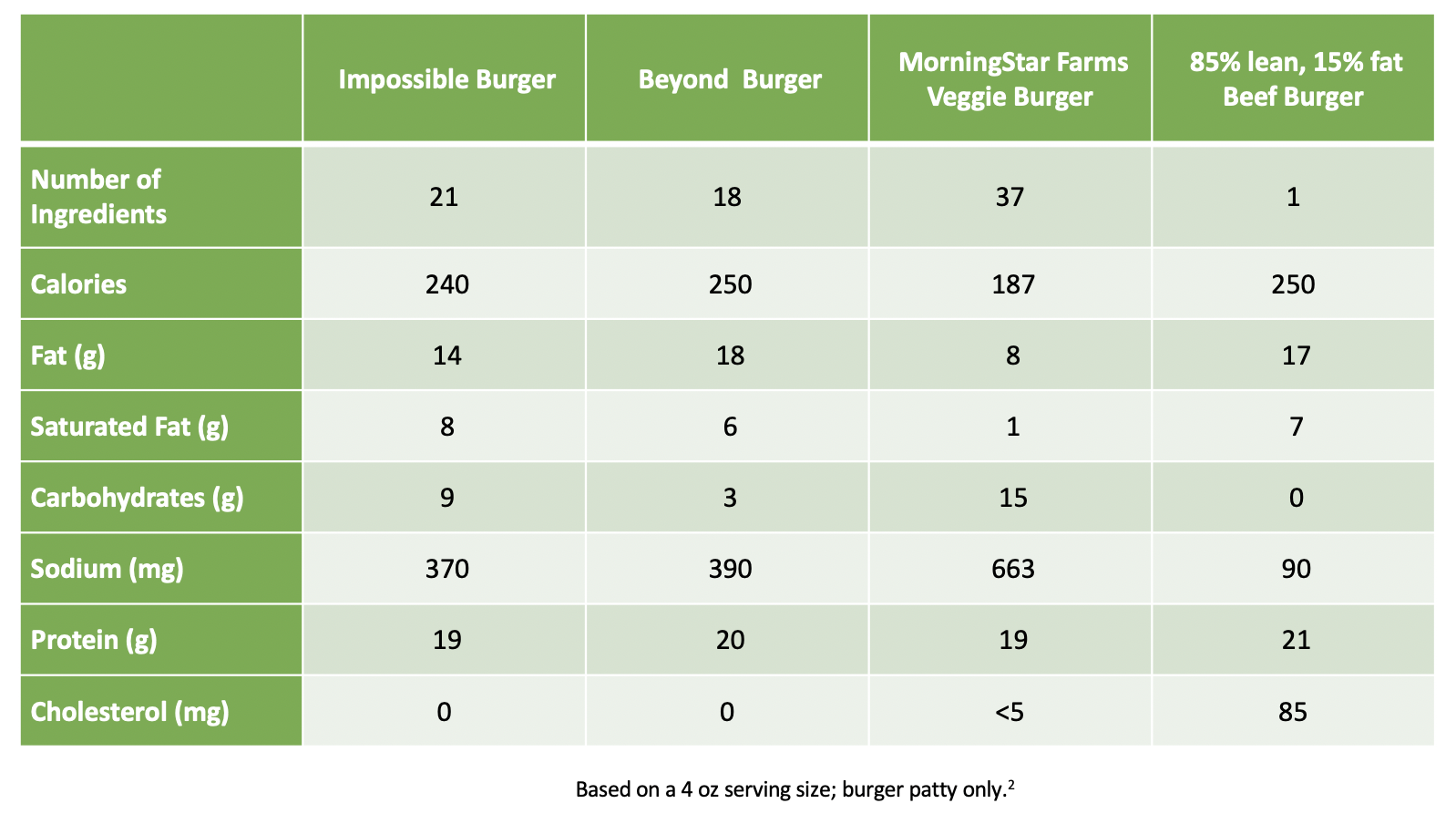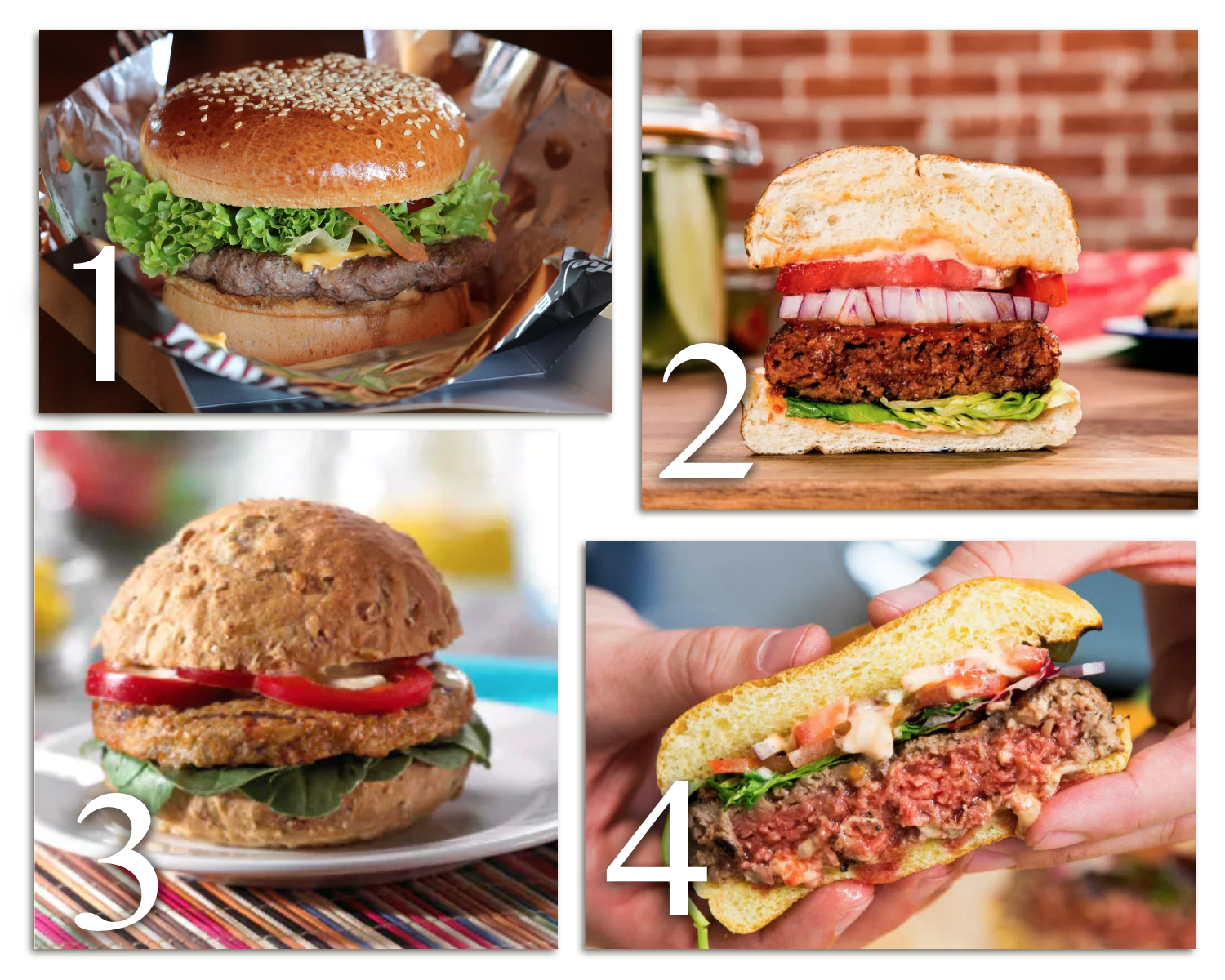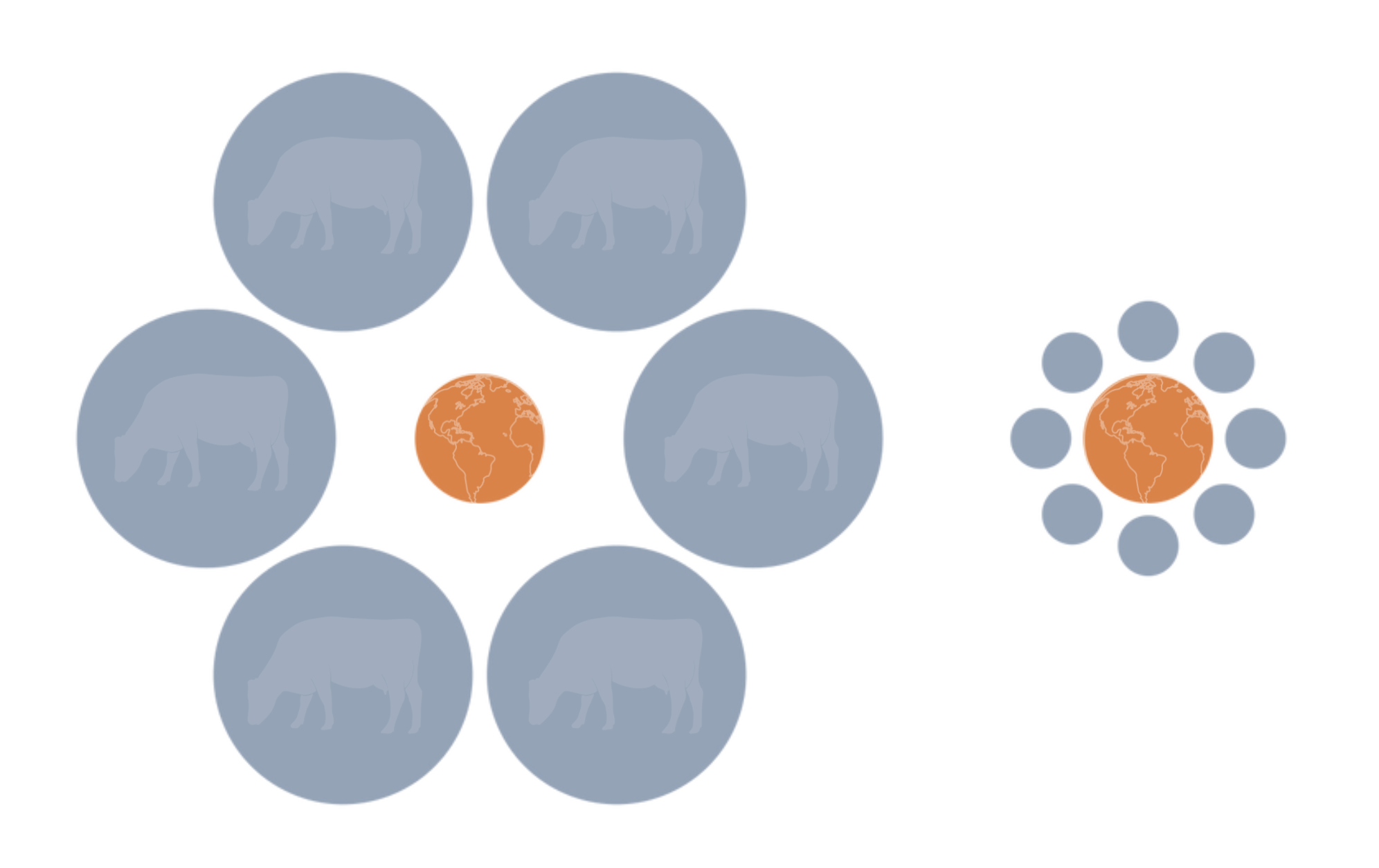Beyond the Beef Background Information Answer Key
Lesson Plan
A Tale of Ii Burgers: Beef and Institute-based Protein
Purpose
Students will compare the components of beef and plant-based burgers past determining the product and processing methods of each product; evaluate the ingredients and nutritional differences between beef and plant-based products; and discuss different points of view in the agricultural industry concerning establish-based proteins and traditional beef. This lesson covers a socioscientific issue and aims to provide students with tools to evaluate scientific discipline within the context of social and economical points of view. Grades 9-12
Vocabulary Words
Across Burger : a plant-based alternative that looks and cooks similar beef, simply does not contain heme or soy
burger: a circular patty of basis beef or found-based products
genetically engineered (GE): an organism or crop whose characteristics have been deliberately modified by manipulating its genetic cloth
hamburger : basis beef; a common proper name for beefiness burgers
heme: an iron-containing molecule found in every living plant and animate being that looks and tastes like blood
Impossible Burger : a plant-based alternative to traditional beef burgers that contains heme and mimics the flavor, odor, and texture of beef
leghemoglobin : an oxygen carrier and hemoprotein found in the nitrogen-fixing root nodules of leguminous plants
meat: the muscle of an fauna used as food
yeast: a microscopic mucus consisting of unmarried oval cells that reproduce by budding, and are capable of converting sugar into alcohol and carbon dioxide
Did You Know? (Ag Facts)
- May 28th is National Hamburger Twenty-four hour period
- Americans eat an estimated fifty billion hamburgers each year.9
- Gregory Sams is credited for creating the first commercially sold "VegeBurger" (veggie burger) in 1982.10
Groundwork Agricultural Connections
Plant-based protein is on the rise and culling burgers are showing up on fast-nutrient menus. As more and more than meatless alternatives become available, consumers may be faced with diverse questions and concerns. What is a found-based burger? How does the Incommunicable Burger compare to a Beyond Burger? Are meatless burgers a healthier alternative?
Many consumers accept enjoyed plant-based proteins—like veggie burgers—for years, just why the sudden surge of popularity? Companies like Incommunicable Foods and Beyond Meat have revolutionized the plant-based industry by creating meatless burgers that actually await, cook, odour, and gustatory modality similar beef. These taste- and lookalike burgers also come advertised as a more environmentally friendly poly peptide alternative, and a possible solution to feeding our growing population.
Beef
Humans began eating beef (domesticated cattle) in 6,500 B.C. Beef cattle have since played an important role in agronomical production. Because of their ruminant digestive arrangement, cows take the unique ability to upcycle homo-inedible forages and byproducts. Feeds like grass, cottonseed meal, and distillers' grain are upcycled into high-quality cuts of protein, iron, and zinc. What most consumers don't realize is that all cattle spend the majority of their lives eating grass and forage products. Calves are raised with their mother on pasture or grass until they are between 6-12 months of age. After weaning, cattle are then fed grain and/or more forages to a finishing weight (1,200-ane,400 pounds) for harvesting. A 1,200-pound steer will produce about 500 pounds of meat including steaks, roasts, and basis beef.v The remaining byproducts from the beef carcass are used for mutual objects such as leather, pet foods, cosmetics, detergents, gum, and brake fluid.
The Beyond Burger
Beyond Meat began in 2009 and their plant-based "Beyond Burger" debuted in 2016. The protein in a Beyond Burger comes from a combination of pea, mung bean, and rice protein. The cerise color of the meat—to resemble beef—comes from beets. Other ingredients in this pop patty include water, expeller-pressed canola oil, refined coconut oil, natural flavors, cocoa butter, methylcellulose, potato starch, apple extract, table salt, potassium chloride, vinegar, lemon juice concentrate, sunflower lecithin, and pomegranate fruit powder. Beyond Meat advertises a plant-based poly peptide that is soy, gluten, and GMO free.
The Impossible Burger
Impossible Foods was founded in 2011 and their constitute-based "Impossible Burger" starting time striking fast-food menus in 2019. The Impossible Burger is a stand-out from other found-based burgers considering the burger patty "bleeds" similar a regular beef burger. This is done using an iron-containing molecule plant in every living plant and animal known as heme. Scientists discovered that heme is what gives meat its odour and flavor. It is too what humans crave when eating meat. Soy leghemoglobin (legume hemoglobin) is a protein plant in plants that carries heme. In the by, researchers at Impossible Foods harvested leghemoglobin straight from the roots of soy plants; however, they soon realized they could produce much more leghemoglobin using fermentation. Leghemoglobin is at present harvested using a yeast engineered with the gene for soy leghemoglobin. The genetically engineered yeast ferments and multiplies, creating large amounts of soy leghemoglobin which contains heme. The heme is so isolated from the yeast and mixed with other ingredients to create the meaty season in the Impossible Burger. This procedure of using genetically engineered yeast allows Impossible Foods to produce heme on a large scale without digging up soy roots, promoting soil erosion, and releasing carbon from the soil.xi
Other ingredients mixed with the soy leghemoglobin (heme) include: h2o, soy poly peptide concentrate, kokosnoot oil, sunflower oil, natural flavors, two% or less of: irish potato protein, methylcellulose, yeast extract, cultured dextrose, food starch modified, salt, soy protein isolate, mixed tocopherols (Vitamin E), zinc gluconate, thiamine hydrochloride (Vitamin B1), sodium ascorbate (Vitamin C), niacin, pyridoxine hydrochloride (Vitamin B6), riboflavin (Vitamin B2), Vitamin B12.12
Are plant-based burgers a healthier culling?
There are many burger options available to consumers whether they are plant-based or fabricated from beef. While establish-based and meatless burgers are a practiced culling, they might not see the same amino acid, vitamin, mineral and antioxidant levels that are found in an eight-ounce piece of reddish meat.2 Consumers tin get 100% of the daily intake of vitamin B12 from i serving of red meat, while a Beyond Burger will account for twenty% of the daily intake of B12.2 The sodium content of each burger varies besides. A Beyond Burger contains 380 milligrams (mg) of sodium, the Incommunicable Burger contains 370 mg of sodium, and a freshly basis beef burger (85% lean) contains 90 mg of sodium.two Plant-based burger patties, however, comprise significantly less cholesterol when compared to a beef patty. Consumers should be aware of the production and processing methods of each burger, also as ingredients and nutrient content so they can select a burger that fits their dietary needs and preferences. Those who are allergic to soy should avoid eating institute-based products that contain soy leghemoglobin.


Interest Approach - Engagement
- Project the Meat or Meatless PowerPoint on the lath. Show slide 1 with 4 photos of different burgers.

- Enquire students to number one-iv on a piece of paper.
- Instruct students to evaluate each burger and try to correctly friction match the picture to the type of burger it is.
- Once students have selected their matches, have them prepare supporting statements and reasonings for their choices.
- Using random selection, ask various students to share their guesses and reasonings with the course.
- Consider asking the following questions to lead a class discussion as students offer their reasonings:
- What qualities of the burger did you consider when studying each burger?
- Was there one burger that was easy or obvious to identify?
- Which burger would you be willing to try?
- Reveal the correct burgers (slide ii) to the students. Did anyone guess all 4 correctly?
- Discuss similarities and differences between the four burger options.
- Consider asking the following questions to lead a class discussion:
- Practice you think all iv burgers (patties) taste the aforementioned?
- The Incommunicable Burger is establish-based, just well-known for "bleeding" like a real beefiness patty. Why is that?
- How does each meat compare nutritionally?
- Inform students that they will explore meat and meat alternatives in lodge to determine similarities and differences betwixt the two.
Procedures
Activity 1: Gallery Walk
- Dissever the form into groups of four students. Give each group one Burger Gallery Walk activity sheet. Inform students that the burger constitute on their activity canvass is the type of burger they will be researching.
- Note: For a medium or big grade, more than one group should be assigned the aforementioned burger to go on the groups in a functional size.
- Supply each group with a large nautical chart or affiche paper, markers, and access to the cyberspace for research.
- Instruct students to research their assigned meat/meat alternative. Remind students to use apparent sources online for enquiry. Enquire students to consider and include the post-obit data on their poster (besides outlined on their activity sheets):
- How long has this meat/meat culling been available?
- How is it produced? (e.g. beefiness cattle are typically raised in feedlots where their diet consists of corn and grain. When the creature reaches 1,200-1,400 pounds, information technology is harvested for meat.)
- What are the benefits of producing and consuming this blazon of burger?
- What are the challenges to producing this type of burger?
- What are the ingredients used to brand this burger?
- Encourage students to make their posters visually appealing for the gallery walk. Ask students to include pictures, diagrams, timelines, and anything else that helps answer the questions.
- As students finish their posters, accept each group display their work on a wall somewhere in the classroom. When everyone is complete, the students will participate in a gallery walk. During the gallery walk, students volition inquire questions and provide feedback to other groups.
- To gear up the gallery walk, carve up each group in half. Two of the students from each group volition walk through the gallery. The other two students will remain by their group poster. The rotating students will evaluate other posters in the classroom and discuss similarities and differences between their meat or meat alternative.
- Notation: If y'all take two groups assigned to each type of burger, conduct a dissever gallery walk rotation for each gear up of four burgers. This will ensure that each group but sees each type of burger in one case.
- Provide each group with sticky notes. Students rotating through the gallery should use pasty notes to ask questions or provide feedback nearly other posters. Instruct students not to echo comments and questions already found on each poster. Each annotate should be unique.
- Determine a time limit for each group rotation (about 3-5 minutes) and allow students to rotate through all the posters in the gallery until they have visited all four types of burgers.
- Ask the students who participated in the gallery walk to now switch with the other 2 members of their group. These students will now complete the gallery walk the aforementioned way.
- After everyone has completed the gallery walk, bring the course dorsum together for a grade give-and-take. Using slides 3-half dozen on the PowerPoint, review each of the meats with the class.
- Permit students to meliorate and update their posters, if needed.
Activity 2: Burgers From Different Points of View
- Write the numbers ane-6 on a embankment ball or soccer ball.

- Now, stand up in the middle of the room and hold the ball up for your students to see. Without rotating the brawl, ask students in various points of the room which numbers(s) they tin run across. For example, ask a student in the front of the classroom what number he or she sees, followed past the same question to a student in the dorsum of the room and so on. Each student will run across all or role of different numbers.
- Inquire your students, "Why, if you are all looking at the same object (the brawl), are you seeing different numbers?" Explain that it is because each has a different "point of view." Each educatee sees different numbers from their point of view. They may see an entire number or role of a number. In that location will exist some numbers that they do not come across at all.
- Use this object lesson to spring into a give-and-take about found-based burgers and beef burgers.
- Enquire students, "What different points of view should be considered when discussing plant-based burgers and beef burgers? How could this be a controversial topic?"
- Let students to share and discuss different points of view related to establish-based protein and traditional beef.
- While holding the brawl in the middle of the room, divide students into six groups based on where they are sitting. Ask each grouping which number they encounter all-time from their position in the classroom. The number that they see volition exist their assigned bespeak of view. For example, if a group sees the number two all-time from their position in the classroom, they will accept menu #2 and their point of view will be a beefiness producer.
- Using the Plant-based Protein Betoken of View cards, assign each grouping a indicate of view to consider.
- Instruct groups to study the data on their card and discuss their point of view as a grouping. What other facts and data could exist added to support their point of view? Groups should enquiry their point of view and find various artifacts (eastward.g. video clips, news manufactures, stance articles, etc.) that would help defend their indicate of view in a presentation or class discussion.
- Note: If fourth dimension is short, the data on the carte should give them the baseline information that they demand.
- Permit students to nowadays their material (indicate of view) to the course or fix up your desks for a classroom word on each of the different points of view.
- As each group presents or discusses their signal of view, remind students of the following:
- Information technology's okay to concord to disagree.
- When looking at or discussing issues, people may use facts, opinions, or personal biases to defend and persuade others to come across her or his point of view.
- Resolving issues and evaluating situations requires that we look at the viewpoints of others to arrive at workable solutions, to form realistic conclusions, or to make our own evidence-based decisions.
Action three: Will Eating Less Meat Save the Planet?
- Projection the Circles Illusion image on the board.

- Inquire students, "Which orange circle is larger?" Virtually students should point to the orange circle on the right.
- Explain to students that each of the orange circles are actually the aforementioned size.
- Inquire students, "Why does the orangish circle on the right appear to be larger?"
- Students should conclude that it has to do with perspective and how the orange circles are presented to united states of america. The orange circle on the left is surrounded past larger circles spaced far apart, and the orange circle on the correct is surrounded past pocket-sized circles that are very shut together. This makes our eyes call up the orange circles are unlike sizes, even though they are not.
- Explain to students that perspective (and the way something is presented to us) can affect the fashion nosotros view something—not merely an epitome on newspaper, only an issue or problem in club as well.
- Direct your students back to the illusion image.
- Ask your students to now consider the cow and globe silhouettes on the circles. After discussing different points of view during activities i and 2, ask students the post-obit questions to lead into a class word:
- What do you lot encounter/hear about eating beefiness and its outcome on the earth and surround?
- Just like the circles in the epitome, can our perspective on something be contradistinct or skewed?
- I conventionalities is that eating less meat volition save the planet. If all of the states prefer a vegetarian diet or vegan lifestyle, will that save the planet?
- Pass out 1 Will Eating Less Meat Save the Planet? graphic organizer to each pupil.
- Show Eating Less Meat Won't Save the Planet. Here's Why to students. This activity tin be done 1 of ii means:
- Option 1: Watch the entire clip every bit a course and inquire students to fill up out the graphic organizer (answer each question) individually. Pause the video to check for understanding and inquire questions. Encourage students to look for bias and identify types of bias if they detect it.
- Option two: Divide the students into 12 groups/pairs and assign each group a question on the graphic organizer. Next to each question is the time frame from the video clip where that question will be answered. Accept each group sentry their assigned time frame and reply their question. When all groups are finished, have each grouping share their questions and answers with the rest of the class.
- Talk over the video clip with students and lead a class discussion.
- Referring back to the illusion prototype ask, "What are examples of how the presentation of statistics impacts the evaluation of the environmental bear upon of beef in our nutrition?" (Measuring green water equally part of the water footprint of beef, systems used to measure carbon emissions, viewing the food livestock consume equally nutrient humans tin can consume, etc.)
- How do we know if statistics online are existence presented to united states accurately? (Talk over strategies for identifying credible resource.)
- What facts or perspectives surprised you when presented in this context?
- Wrap up the form discussion and remind students to check for credited sources on articles or videos posted online. Explain to students that some facts or statistics might be presented to usa in ways that tin can alter our view or perception—just like the circles in the image.
Concept Elaboration and Evaluation
After conducting these activities, review and summarize the post-obit key points:
- Beef and the ingredients independent in institute-based burgers are produced on farms.
- The production of all food requires the use of natural resources such as arable land, water, and soil nutrients.
- Food product systems are influenced past consumer choices.
- There are many points of view to consider when comparison beefiness and institute-based burgers. Topics of consideration include ethics, bachelor natural resource, nutrition, and food safety.
Enriching Activities
-
Conduct a blind sense of taste test with students to run into if they tin can identify which burger contains a beef patty and which contains an alternative meat patty. Burgers could be obtained from a local fast-nutrient eating house if time and distance allows.
-
Using the Compliments of Cattle poster, introduce students to all of the by-products nosotros obtain from cattle. Hash out a hypothetical situation. If found-based burgers decreased (significantly) the raising of cattle for beef, what other every-day items could exist impacted?
-
Listen to the AgFuture podcast, Culling "meat" vs. traditional beef - Amanda Radke. Discuss the topics addressed in the podcast. Consider the following questions to engage your students in the podcast:
- Why is consumer choice important? How does it relate to beefiness vs. institute-based proteins?
- Constitute-based proteins are advertised as environmentally and ethically superior to beef? Is this true?
- Why can't the land used to graze cattle simply be converted to farm land to grow food?
- What by-products would be lost if the cattle manufacture declined?
- Should alternative meat companies exist able to call their products "meat" or "beef?" Why or why not?
-
Evidence the video, Heme - The Magic Ingredient in the Impossible BurgerTM for students to larn more near one ingredient in the Incommunicable Burger that makes the plant-based burger more closely resemble a beef burger.
Arrangement Amalgamation
Utah Agriculture in the Classroom
| | We welcome your feedback. Please take a minute to share your thoughts on this lesson. |
Source: https://agclassroom.org/matrix/lesson/722/
Post a Comment for "Beyond the Beef Background Information Answer Key"